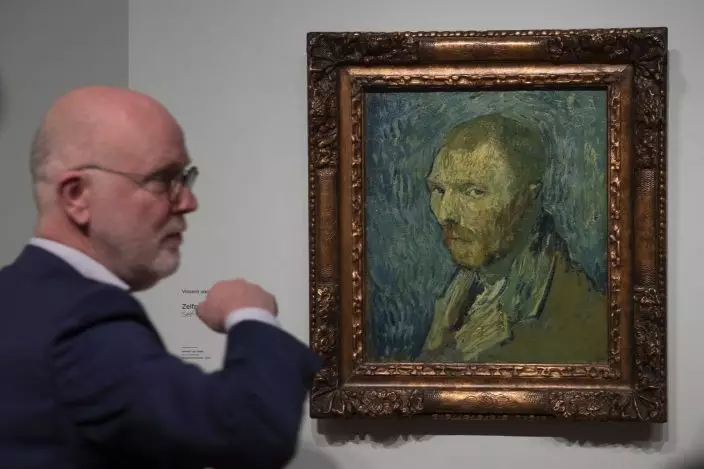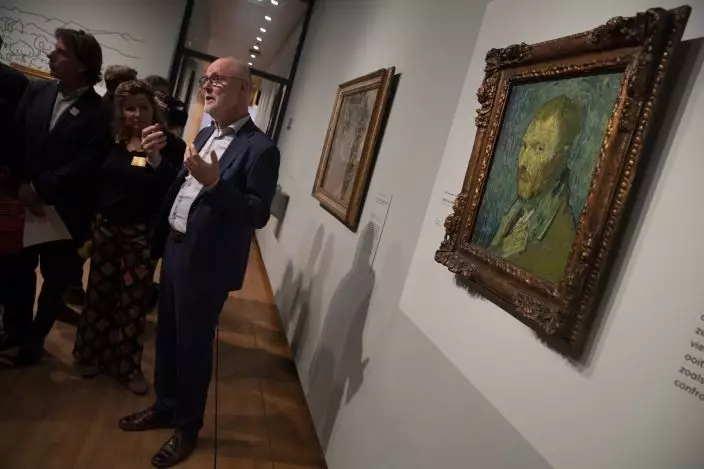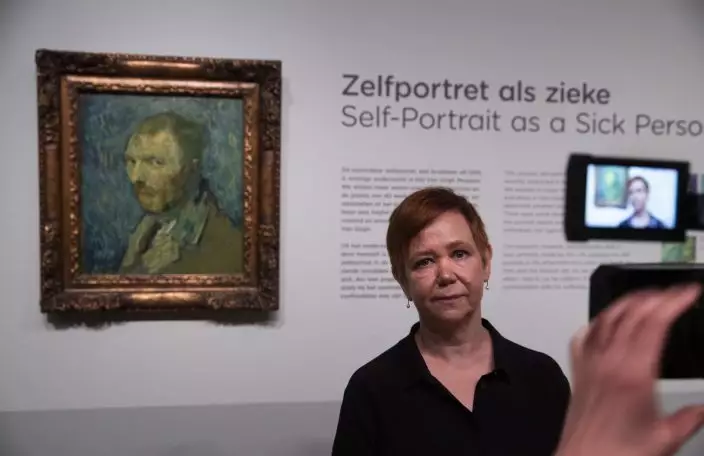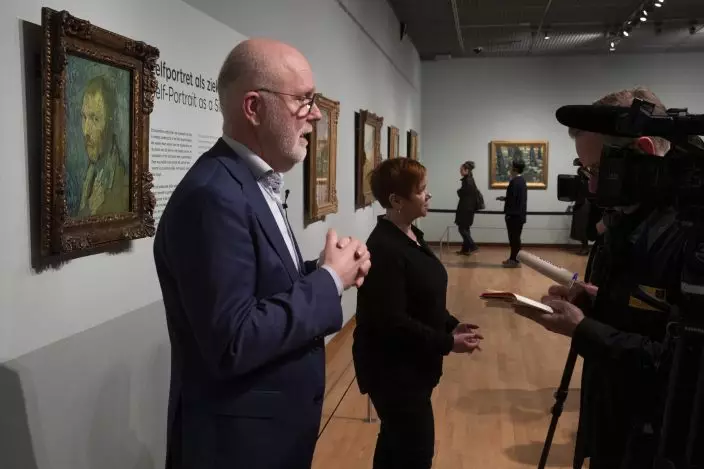After years of doubts about its authenticity, experts in Amsterdam have confirmed that a Vincent van Gogh self-portrait was indeed painted by the Dutch master as he recovered in a French asylum from a mental breakdown.
Van Gogh Museum researcher Louis van Tilborgh dispelled the doubts Monday, saying the oil-on-canvas painting of the anguished-looking painter was completed in the late summer of 1889 while Van Gogh was at the Saint-Remy asylum in southern France.
Questions about the painting rose in the 1970s. The use of a palette knife to flatten brush strokes on Van Gogh's face and what were then considered to be unusual colors in the painting led to speculation about the authenticity of the work, which was bought as a genuine Van Gogh in 1910 by Norway's National Museum.

A journalist takes a picture of the previously contested painting by Dutch master Vincent van Gogh, a 1889 self-portrait, of which the authenticity was confirmed during a press conference in Amsterdam, Netherlands, Monday, Jan. 20, 2020. The painting, which belongs to the National Museum in Norway, was painted at the Saint-Paul de Mausole psychiatric institution in Saint-Remy de Provence, France. (AP PhotoPeter Dejong)
In an attempt to put those doubts to rest, the museum asked the Van Gogh Museum to analyze the painting in 2014.
“It feels really reassuring to know that its genuine,” said Mai Britt Guleng of the Norwegian museum.
Van Tilborgh said the use of an unprimed canvas and a muddy green color were, in fact, typical of Van Gogh's time in Saint-Remy in 1889.

Senior researcher Louis van Tilborgh talks to journalists about the previously contested painting by Dutch master Vincent van Gogh, a 1889 self-portrait, of which the authenticity was confirmed during a press conference in Amsterdam, Netherlands, Monday, Jan. 20, 2020. The painting, which belongs to the National Museum in Norway, was painted at the Saint-Paul de Mausole psychiatric institution in Saint-Remy de Provence, France. (AP PhotoPeter Dejong)
What sets the work apart is Van Gogh's use of a palette knife.
“So he has painted it and during the process he suddenly decides that it has to become flat,” Van Tilborgh said. “We tend to think that it has to do with the fact that it's made during a period of psychosis.”
Van Tilborgh said Van Gogh used painting as both a way of portraying his mental breakdown and of helping him to recover.

Van Gogh Museum's senior researcher Louis van Tilborgh gestures as he talks to journalists about the previously contested painting by Dutch master Vincent van Gogh, a 1889 self-portrait, of which the authenticity was confirmed during a press conference in Amsterdam, Netherlands, Monday, Jan. 20, 2020. The painting, which belongs to the National Museum in Norway, was painted at the Saint-Paul de Mausole psychiatric institution in Saint-Remy de Provence, France. (AP PhotoPeter Dejong)
“He wanted to say in this picture that he was an ill person and so it's a kind of therapeutic work we tend to think," he said. "He was a Protestant and as a Protestant you have to accept the facts of life — if you suffer, you have to face the suffering.”
Norway's most famous artistic son, painter Edvard Munch, whose iconic work, “The Scream,” also is a vivid expression of mental anguish, was fascinated by the Van Gogh painting.
“He thought it was one of the best of the collection of the national gallery but he also found it scary, because of the gaze from the self-portrait staring back at him,” Guleng said.

Norway's National Museum curator Mai Britt Guleng talk about the previously contested painting by Dutch master Vincent van Gogh, a 1889 self-portrait, left, of which the authenticity was confirmed during a press conference in Amsterdam, Netherlands, Monday, Jan. 20, 2020. The painting, which belongs to the National Museum in Norway, was painted at the Saint-Paul de Mausole psychiatric institution in Saint-Remy de Provence, France. (AP PhotoPeter Dejong)
The painting will remain on display at the Van Gogh Museum in Amsterdam before returning to Oslo in 2021, when the National Museum, currently closed for renovation, reopens in a new building.
“When we delivered the painting in ‘14 they warned us and said ’You might not like the results and it might be that we will never find out.'” Guleng said. “So we were very happy when we got the news.”

Van Gogh Museum senior researcher Louis van Tilborgh, left, and Norway's National Museum curator Mai Britt Guleng, center, talk about the previously contested painting by Dutch master Vincent van Gogh, a 1889 self-portrait, left, of which the authenticity was confirmed during a press conference in Amsterdam, Netherlands, Monday, Jan. 20, 2020. The painting, which belongs to the National Museum in Norway, was painted at the Saint-Paul de Mausole psychiatric institution in Saint-Remy de Provence, France. (AP PhotoPeter Dejong)


